Perception and Acceptance of Shade Variances in the Smile
Abstract
:1. Introduction
2. Materials and Methods
2.1. Dental Arch Models
2.2. Photograph Recording and Editing
2.3. Image Presentation
2.4. Participants
2.5. Statistical Methods
2.6. Data Availability
3. Results
3.1. Participants
3.2. Evaluation of Color and Harmony
3.2.1. Frequency Distribution of Ratings
3.2.2. Influence of Color Distance (ΔE Value) on Ratings
3.2.3. Influence of Shade Variance in the Dental Arch on Ratings
3.2.4. Influence of Age of Participants on Ratings
3.2.5. Influence of Gender of Participants on Ratings
3.2.6. Influence of Education Level of Participants on Evaluation
3.3. Perceptibility and Acceptability Thresholds Using CIELAB Color Difference Formula
3.4. Perceptibility and Acceptability Thresholds Using CIEDE2000 Formula
4. Discussion
4.1. Color and Harmony Rating
4.2. Influence of Overall Shade Difference and Color Inhomogenity
4.3. Influence of Age on Rating
4.4. Influence of Gender on Rating
4.5. Influence of Education Level on Rating
4.6. Influence of the Use of Different Color Difference Formulas
4.7. Limitations of the Study
5. Conclusions
- The color difference between two observed objects is in negative relationship to the rating of color homogeneity and esthetic quality. However, there is a nonlinear dependence of the ratings of color and harmony on the color differences not only of the directly adjacent teeth.
- The age of the participants has a low effect on color and harmony rating. There is a statistically significant difference in color ratings between participants aged 26–40 and those aged 18–25. However, the explanatory potential is low.
- The gender of the participants influences the rating of color homogeneity and esthetic quality. Women evaluate color homogeneity and esthetic quality more critically and give lower ratings than men.
- The education level of the participants has an effect on rating of color homogeneity and esthetic quality. A higher education level is related to higher ratings.
Author Contributions
Funding
Institutional Review Board Statement
Informed Consent Statement
Data Availability Statement
Acknowledgments
Conflicts of Interest
References
- Nandhini, T.; Rakshagan, V.; Jain, A. A survey to assess the patient’s satisfaction on denture base color, customization, and esthetics made by undergraduates. Drug. Invent. Today 2018, 10, 2222–2227. [Google Scholar]
- Ruyter, I.E.; Nilner, K.; Moller, B. Color stability of dental composite resin materials for crown and bridge veneers. Dent. Mater. 1987, 3, 246–251. [Google Scholar] [CrossRef] [PubMed]
- Waller, T.; Evci, E.; Hämmerle, C.; Hüsler, J.; Jung, R.; Thoma, D. Perceptibility and Acceptability of Color Differences of Single-Tooth Implants at the Restoration and Mucosa Levels: An Exploratory Clinical Study. Int. J. Prosthodont. 2020, 33, 487–492. [Google Scholar] [CrossRef]
- Pérez, M.M.; Herrera, L.J.; Carrillo, F.; Pecho, O.E.; Dudea, D.; Gasparik, C.; Ghinea, R.; Bona, A.D. Whiteness difference thresholds in dentistry. Dent. Mater. Off. Publ. Acad. Dent. Mater. 2019, 35, 292–297. [Google Scholar] [CrossRef]
- Thoma, D.S.; Ioannidis, A.; Fehmer, V.; Michelotti, G.; Jung, R.E.; Sailer, I. Threshold Values for the Perception of Color Changes in Human Teeth. Int. J. Periodontics Restor. Dent. 2016, 36, 777–783. [Google Scholar] [CrossRef] [PubMed]
- Alghazali, N.; Burnside, G.; Moallem, M.; Smith, P.; Preston, A.; Jarad, F.D. Assessment of perceptibility and acceptability of color difference of denture teeth. J. Dent. 2012, 40, e10–e17. [Google Scholar] [CrossRef]
- Paravina, R.D.; Pérez, M.M.; Ghinea, R. Acceptability and perceptibility thresholds in dentistry: A comprehensive review of clinical and research applications. J. Esthet. Restor. Dent. 2019, 31, 103–112. [Google Scholar] [CrossRef]
- Douglas, R.D.; Brewer, J.D. Acceptability of shade differences in metal ceramic crowns. J. Prosthet. Dent. 1998, 79, 254–260. [Google Scholar] [CrossRef]
- Lindsey, D.T.; Wee, A.G. Perceptibility and acceptability of CIELAB color differences in computer-simulated teeth. J. Dent. 2007, 35, 593–599. [Google Scholar] [CrossRef]
- Salas, M.; Lucena, C.; Herrera, L.J.; Yebra, A.; Della Bona, A.; Pérez, M.M. Translucency thresholds for dental materials. Dent. Mater. 2018, 34, 1168–1174. [Google Scholar] [CrossRef]
- Tejada-Casado, M.; Pérez, M.M.; Della Bona, A.; Lübbe, H.; Ghinea, R.; Herrera, L.J. Chroma-dependence of CIEDE2000 acceptability thresholds for dentistry. J. Esthet. Restor. Dent. 2024, 36, 469–476. [Google Scholar] [CrossRef]
- Pecho, O.E.; Ghinea, R.; Perez, M.M.; Bona, A.D. Influence of Gender on Visual Shade Matching in Dentistry. J. Esthet. Restor. Dent. 2017, 29, E15–E23. [Google Scholar] [CrossRef]
- Strajnić, L.; Bulatović, D.; Stančić, I.; Živković, R. Self-perception and satisfaction with dental appearance and aesthetics with respect to patients’ age, gender, and level of education. Srp. Arh. Celok. Lek. 2016, 144, 580–589. [Google Scholar] [CrossRef]
- Gasparik, C.; Grecu, A.G.; Culic, B.; Badea, M.E.; Dudea, D. Shade-Matching Performance Using a New Light-Correcting Device. J. Esthet. Restor. Dent. 2015, 27, 285–292. [Google Scholar] [CrossRef]
- Haddad, H.J.; Jakstat, H.A.; Arnetzl, G.; Borbely, J.; Vichi, A.; Dumfahrt, H.; Renault, P.; Corcodel, N.; Pohlen, B.; Marada, G.; et al. Does gender and experience influence shade matching quality? J. Dent. 2009, 37, e40–e44. [Google Scholar] [CrossRef]
- Aswini, K.K.; Ramanarayanan, V.; Rejithan, A.; Sajeev, R.; Suresh, R. The effect of gender and clinical experience on shade perception. J. Esthet. Restor. Dent. 2019, 31, 608–612. [Google Scholar] [CrossRef]
- Poljak-Guberina, R.; Celebic, A.; Powers, J.M.; Paravina, R.D. Colour discrimination of dental professionals and colour deficient laypersons. J. Dent. 2011, 39, e17–e22. [Google Scholar] [CrossRef] [PubMed]
- Gómez-Polo, C.; Portillo Muñoz, M.; Lorenzo Luengo, M.C.; Vicente, P.; Galindo, P.; Martín Casado, A.M. Comparison of the CIELab and CIEDE2000 color difference formulas. J. Prosthet. Dent. 2016, 115, 65–70. [Google Scholar] [CrossRef]
- Sharma, G.; Wu, W.; Dala, E.N. The CIEDE2000 Color-Difference Formula: Implementation Notes, Supplementary Test Data, and Mathematical Observations. Color Res. Appl. 2005, 30, 21–30. [Google Scholar] [CrossRef]
- Gómez-Polo, C.; Montero, J.; Gómez-Polo, M.; Martin Casado, A. Comparison of the CIELab and CIEDE 2000 Color Difference Formulas on Gingival Color Space. J. Prosthodont. 2020, 29, 401–408. [Google Scholar] [CrossRef] [PubMed]
- Paolone, G.; Pavan, F.; Mandurino, M.; Baldani, S.; Guglielmi, P.C.; Scotti, N.; Cantatore, G.; Vichi, A. Color stability of resin-based composites exposed to smoke. A systematic review. J. Esthet. Restor. Dent. 2023, 35, 309–321. [Google Scholar] [CrossRef] [PubMed]
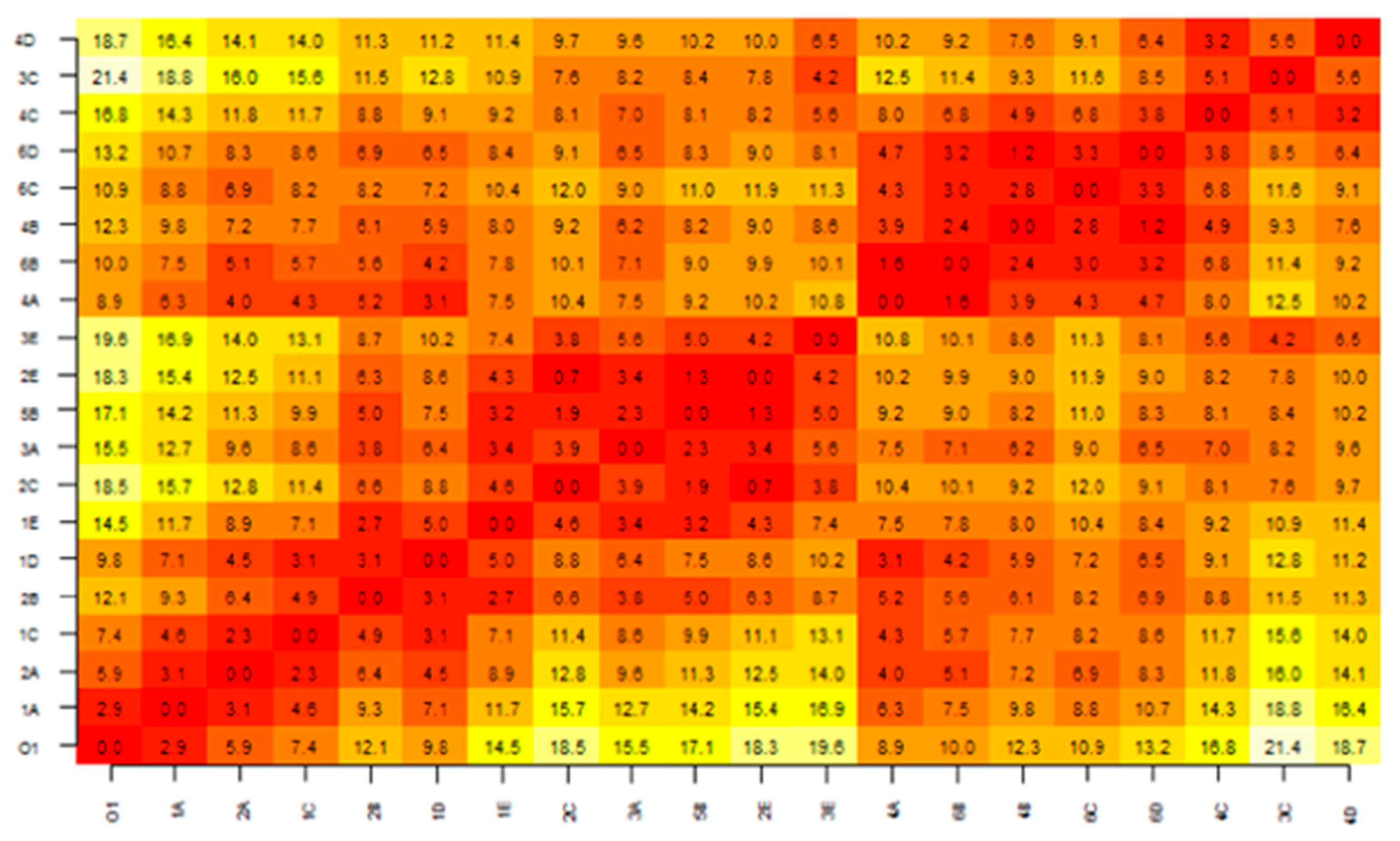


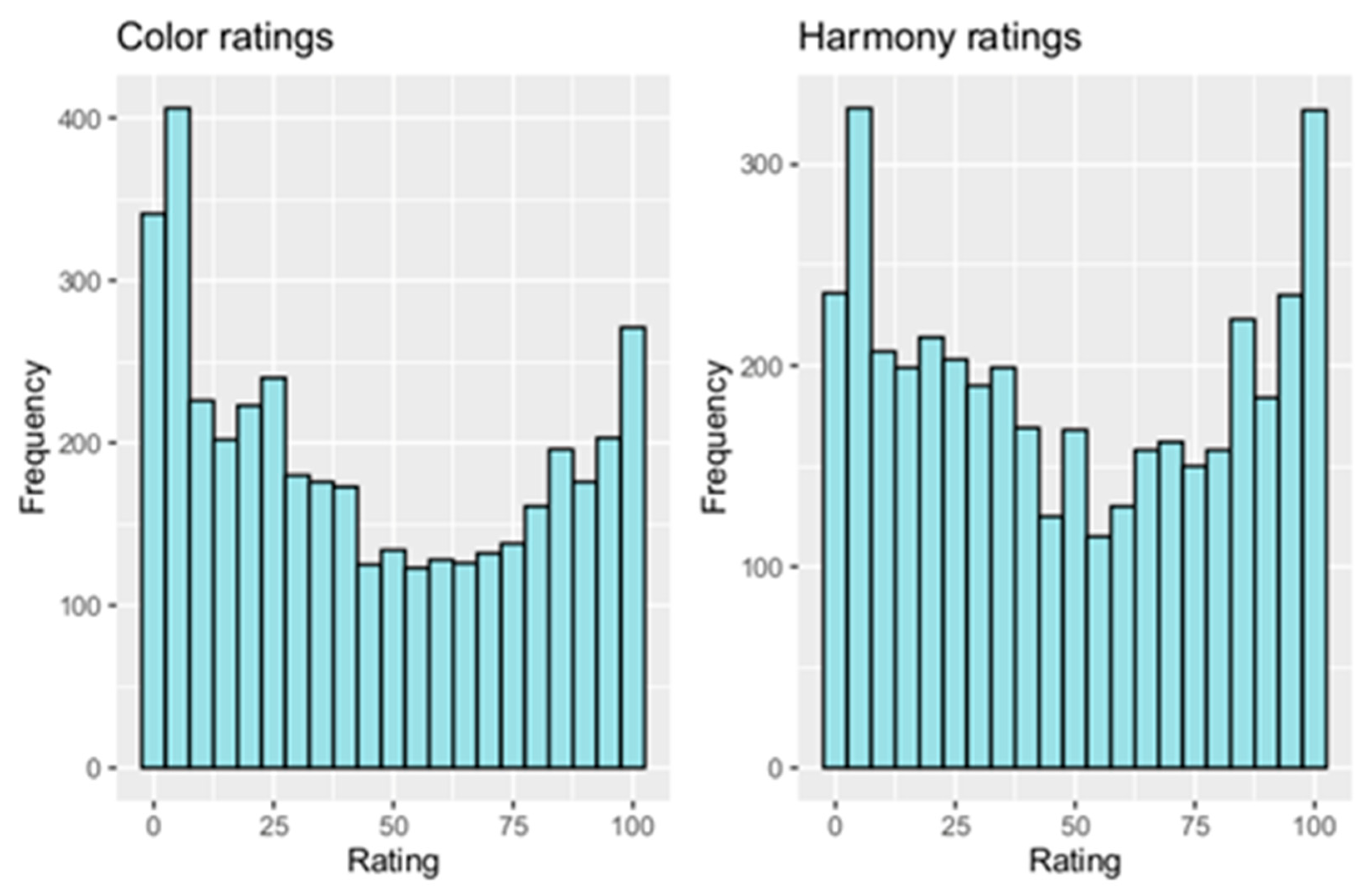
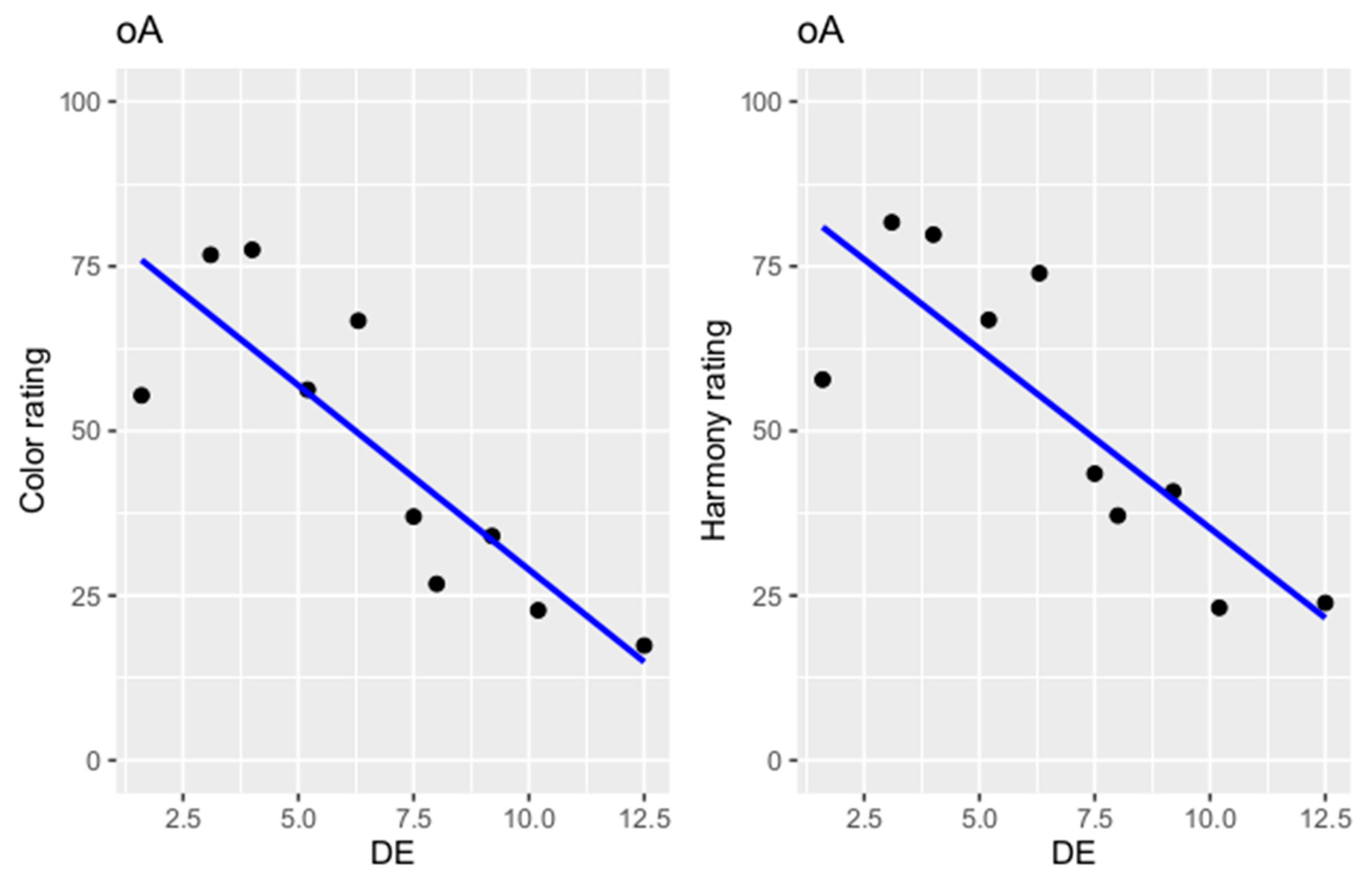
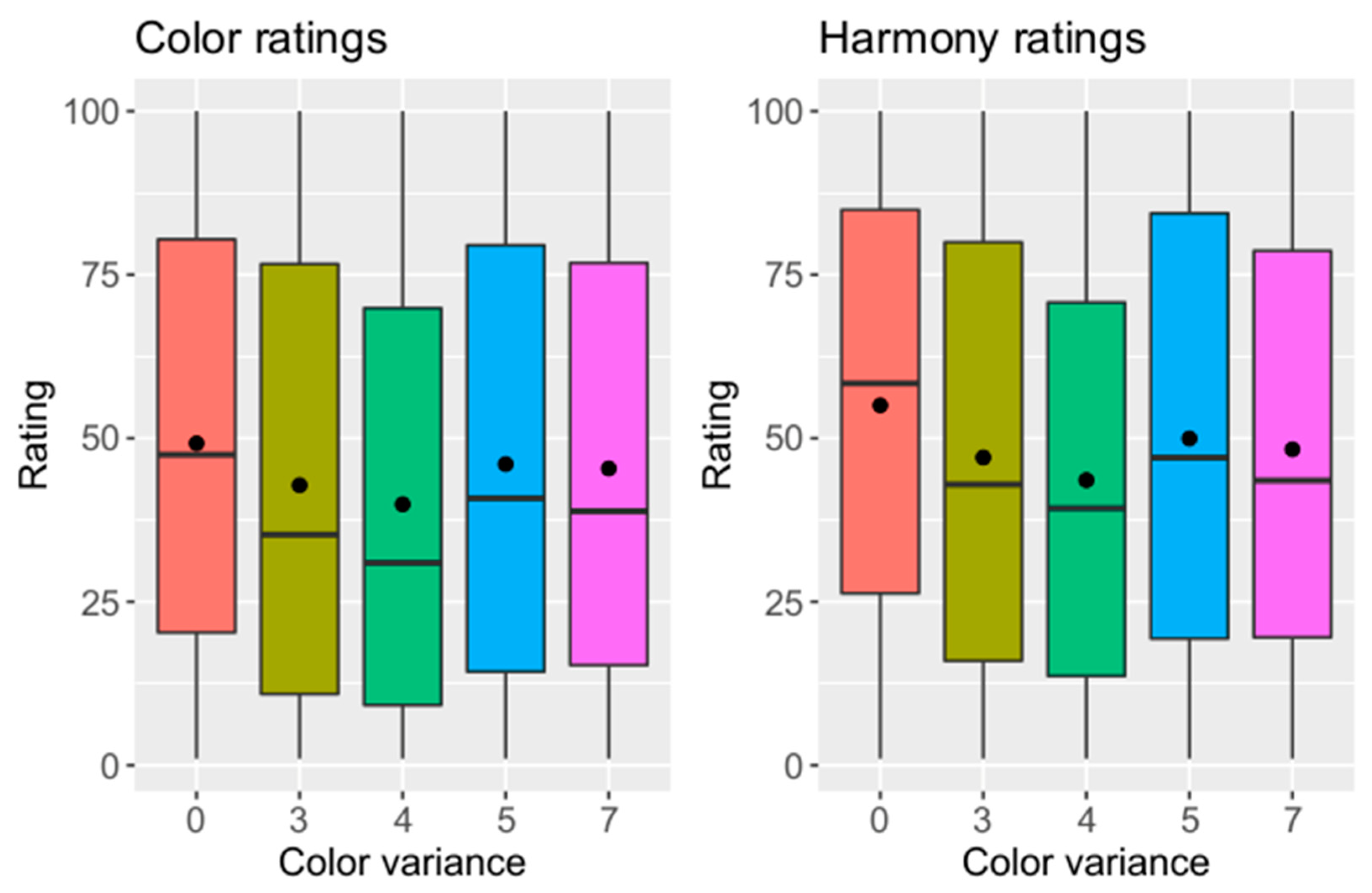
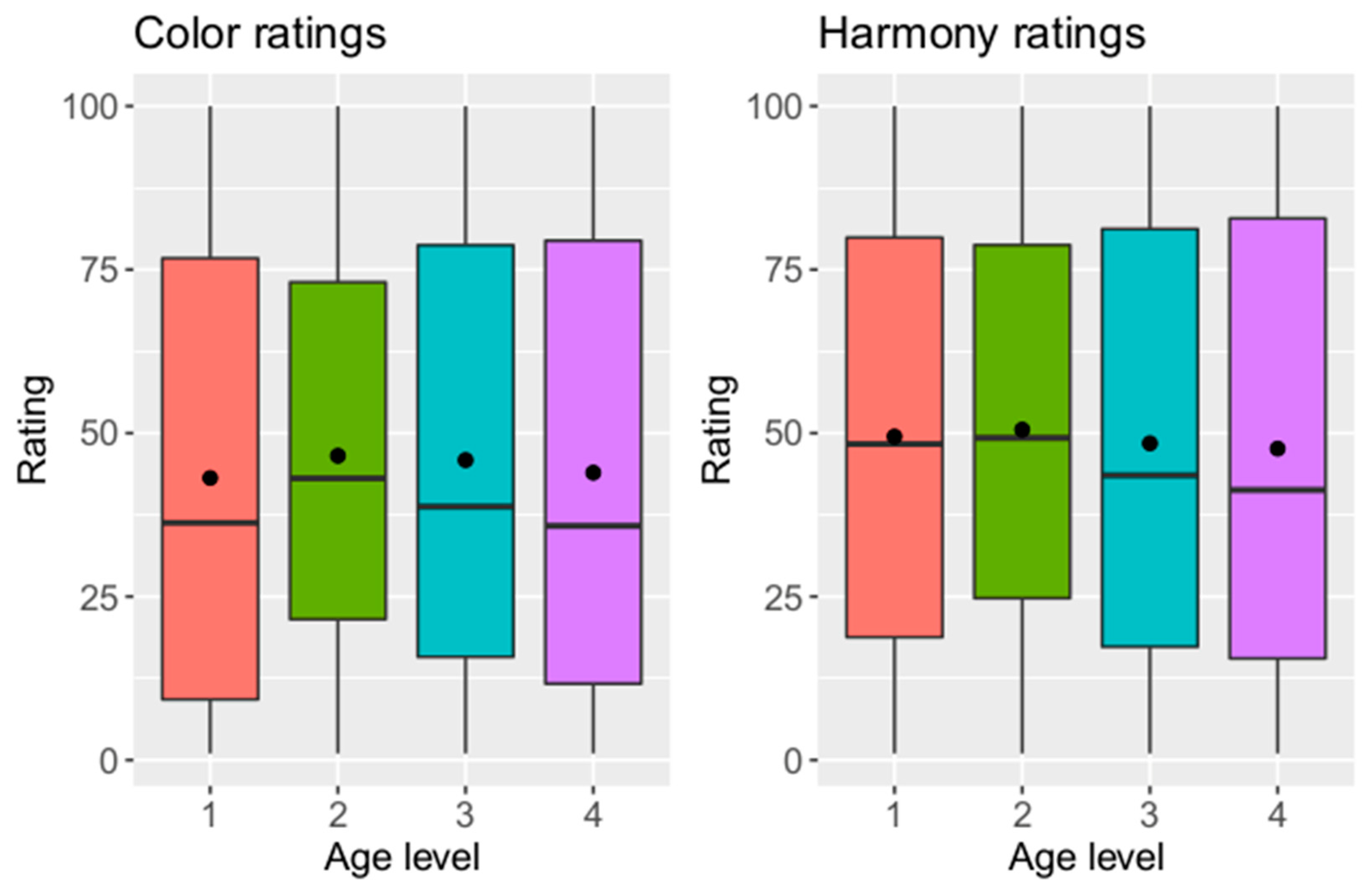
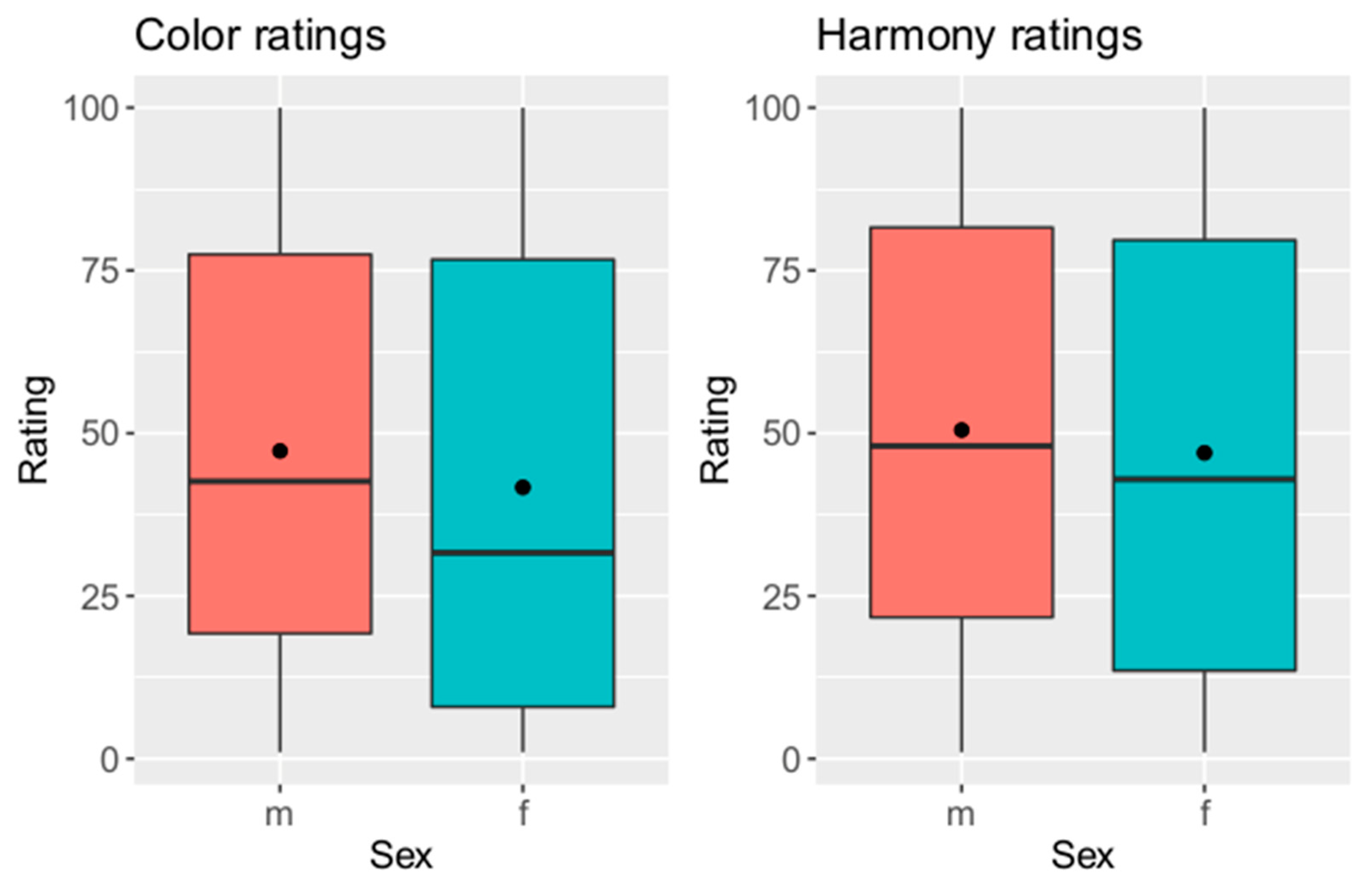
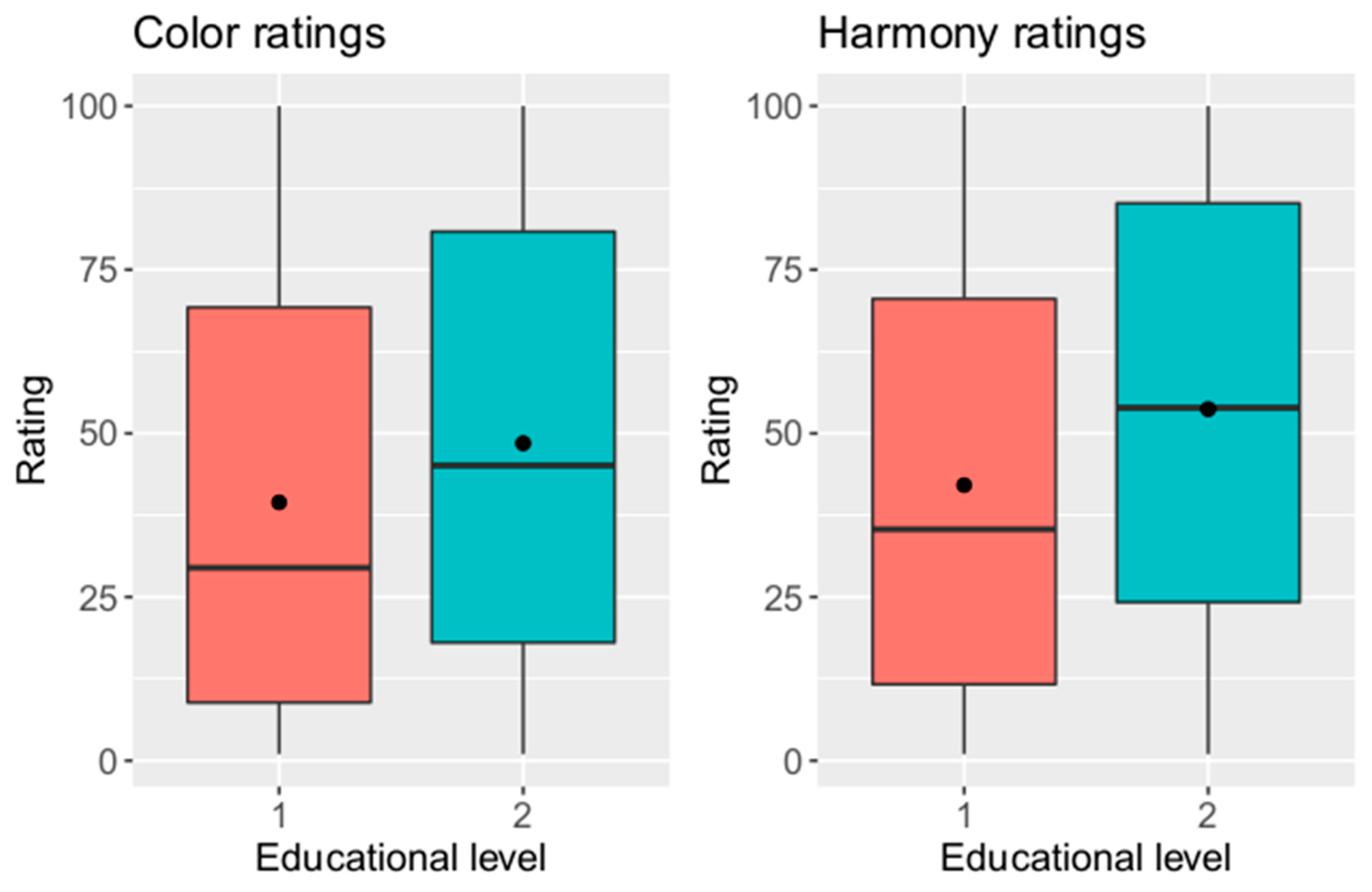
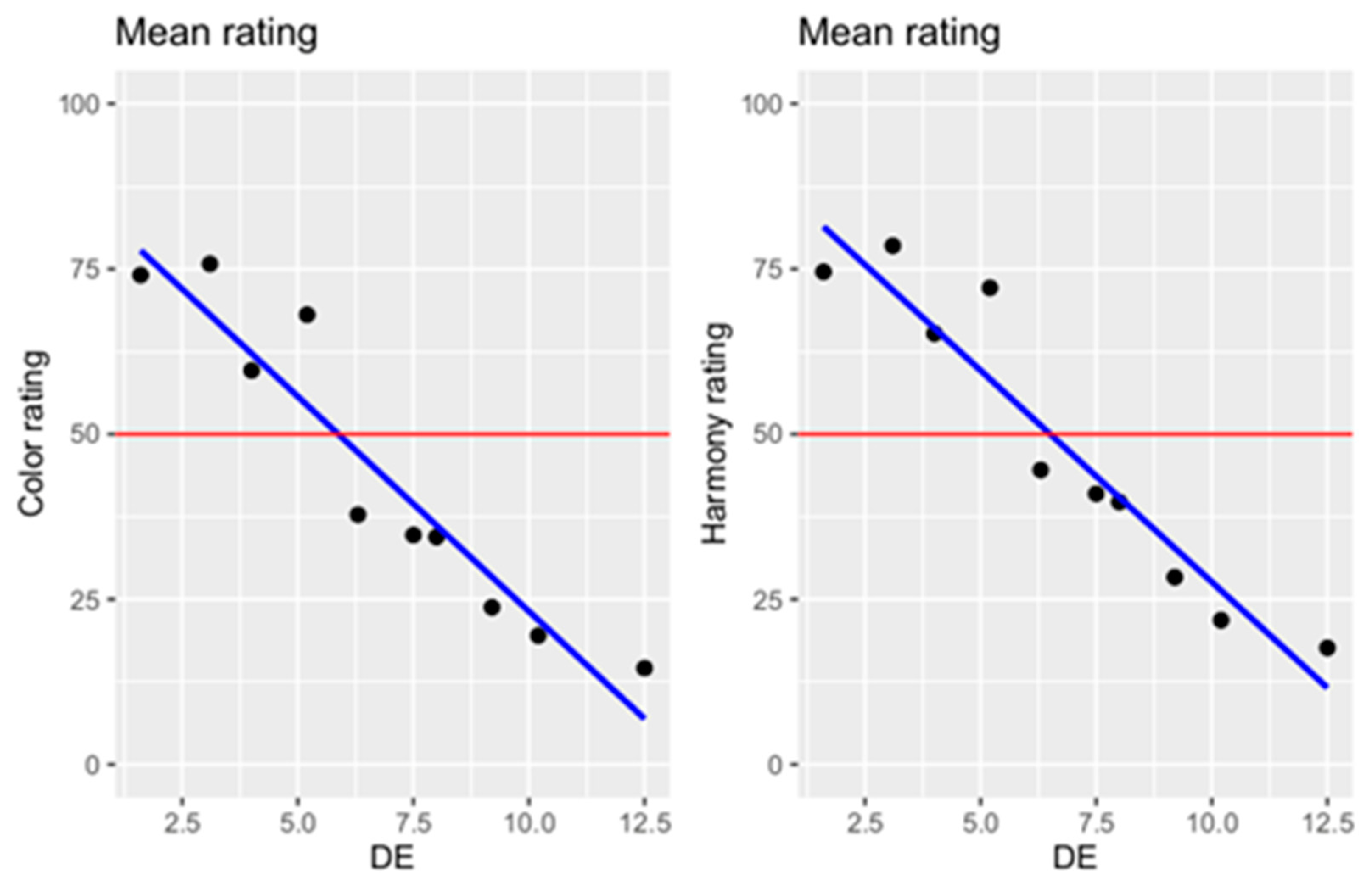
| Version | Reference Tooth | Second Incisor | Canine | ΔE1 | ΔE2 |
|---|---|---|---|---|---|
| 1 | 4A | 4A | 4A | 0.0 | 0.0 |
| 2 | 4A | 1D | 2B | 3.1 | 3.1 |
| 3 | 4A | 2A | 1D | 4.0 | 4.5 |
| 4 | 4A | 2B | 5B | 5.0 | 5.2 |
| 5 | 4A | 3A | 4C | 7.5 | 7.0 |
| Version | Study Name | Tooth in Dental Arch | Shade |
|---|---|---|---|
| 1 | oA | 13 | 4A |
| 12 | 4A | ||
| 11 | 4A | ||
| 21 | changed | ||
| 22 | 4A | ||
| 23 | 4A | ||
| 2 | D3 | 13 | 2B |
| 12 | 1D | ||
| 11 | 4A | ||
| 21 | changed | ||
| 22 | 1D | ||
| 23 | 2B | ||
| 3 | D4 | 13 | 1D |
| 12 | 2A | ||
| 11 | 4A | ||
| 21 | changed | ||
| 22 | 1D | ||
| 23 | 2A | ||
| 4 | D5 | 13 | 5B |
| 12 | 2B | ||
| 11 | 4A | ||
| 21 | changed | ||
| 22 | 2B | ||
| 23 | 5B | ||
| 5 | D7 | 13 | 6B |
| 12 | 3A | ||
| 11 | 4A | ||
| 21 | changed | ||
| 22 | 4A | ||
| 23 | 6B |
| Shades of Changed Tooth (21) |
|---|
| 4A (only in version 1) |
| 6B |
| 1D |
| 2A |
| 2B |
| 1A |
| 3A |
| 4C |
| 5B |
| 2E |
| 3C |
| Individual Parameter | Group/ Code | Definition | Quantity (n = 80) |
|---|---|---|---|
| Age | 1 | age between 18 and 25 (teenagers) | 21 |
| 2 | age between 26 and 40 (young adults) | 16 | |
| 3 | age between 41 and 59 (adults) | 21 | |
| 4 | age between 60 and 76 (older people) | 22 | |
| Gender | 1 | Woman | 36 |
| 2 | Man | 44 | |
| Education level | 1 | main school degree or intermediate educational qualification (low education level) | 33 |
| 2 | general high school diploma or technical college entrance qualification (high education level) | 47 |
| ΔE Value | Mean Color Rating | Mean Harmony Rating |
|---|---|---|
| 0.0 | 70.83 | 76.68 |
| 1.6 | 74.07 | 74.56 |
| 3.1 | 75.75 | 78.50 |
| 4.0 | 59.63 | 65.22 |
| 5.2 | 68.06 | 72.13 |
| 6.3 | 37.80 | 44.57 |
| 7.5 | 34.74 | 40.97 |
| 8.0 | 34.43 | 39.70 |
| 9.2 | 23.79 | 28.34 |
| 10.2 | 19.51 | 21.84 |
| 12.5 | 14.58 | 17.65 |
| Rating | Coefficient | Regression Coefficient | SD | T | Significance |
|---|---|---|---|---|---|
| color rating | y-axis/y-intercept | 88.19 | 5.63 | 15.67 | 1.74 × 10−7 * |
| DE | −6.50 | 0.75 | −8.65 | 2.493 × 10−5 * | |
| harmony rating | y-axis/y-intercept | 91.62 | 5.29 | 17.33 | 1.25 × 10−7 * |
| DE | −6.40 | 0.71 | −9.06 | 1.76 × 10−5 * |
| Dental Arch Version | Code of Shade Variance (VarEK) | ΔE1 | ΔE2 |
|---|---|---|---|
| 1 (oA) | 0 | 0 | 0 |
| 2 (D3) | 3 | 3.1 | 3.1 |
| 3 (D4) | 4 | 4.0 | 4.5 |
| 4 (D5) | 5 | 5.0 | 5.2 |
| 5 (D7) | 7 | 7.5 | 7.0 |
| Color Rating | Harmony Rating | |||||||||
|---|---|---|---|---|---|---|---|---|---|---|
| VarEK | 0 | 3 | 4 | 5 | VarEK | 0 | 3 | 4 | 5 | |
| shade difference | 3 | 0.000 | 3 | 6.1 × 10−96 | ||||||
| 4 | 0.000 | 0.359 | 4 | 0.000 | 0.228 | |||||
| 5 | 0.197 | 0.314 | 0.002 | 5 | 0.017 | 0.345 | 0.001 | |||
| 7 | 0.127 | 0.429 | 0.004 | 1.000 | 7 | 0.000 | 0.906 | 0.026 | 0.867 | |
| age group | VarEK | 1 | 2 | VarEK | 1 | 2 | 3 | |||
| 2 | 0.014 | 2 | 0.890 | |||||||
| 3 | 0.060 | 0.905 | 3 | 0.870 | 0.480 | |||||
| 4 | 0.640 | 0.212 | 0.531 | 4 | 0.630 | 0.250 | 0.970 | |||
| Model Version | ΔE_1 (CIELab) | ΔE_2 (CIELab) | ΔE00_1 (CIEDE2000) | ΔE00_2 (CIEDE2000) |
|---|---|---|---|---|
| 1 | 0.0 | 0.0 | 0.0 | 0.0 |
| 2 | 3.1 | 3.1 | 2.2 | 2.0 |
| 3 | 4.0 | 4.5 | 3.4 | 3.7 |
| 4 | 5.0 | 5.2 | 5.2 | 3.0 |
| 5 | 7.5 | 7.0 | 3.9 | 5.3 |
Disclaimer/Publisher’s Note: The statements, opinions and data contained in all publications are solely those of the individual author(s) and contributor(s) and not of MDPI and/or the editor(s). MDPI and/or the editor(s) disclaim responsibility for any injury to people or property resulting from any ideas, methods, instructions or products referred to in the content. |
© 2024 by the authors. Licensee MDPI, Basel, Switzerland. This article is an open access article distributed under the terms and conditions of the Creative Commons Attribution (CC BY) license (https://creativecommons.org/licenses/by/4.0/).
Share and Cite
Wesselbaum, J.; Dirksen, D.; Runte, C.; Becker, A. Perception and Acceptance of Shade Variances in the Smile. Dent. J. 2024, 12, 260. https://doi.org/10.3390/dj12080260
Wesselbaum J, Dirksen D, Runte C, Becker A. Perception and Acceptance of Shade Variances in the Smile. Dentistry Journal. 2024; 12(8):260. https://doi.org/10.3390/dj12080260
Chicago/Turabian StyleWesselbaum, Jana, Dieter Dirksen, Christoph Runte, and Alexander Becker. 2024. "Perception and Acceptance of Shade Variances in the Smile" Dentistry Journal 12, no. 8: 260. https://doi.org/10.3390/dj12080260







